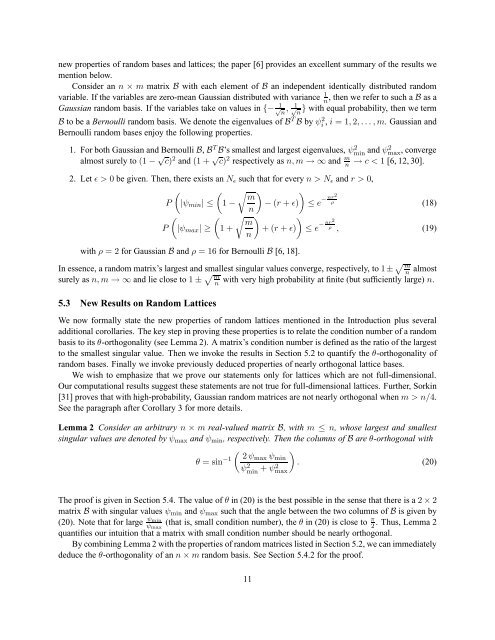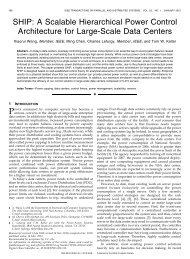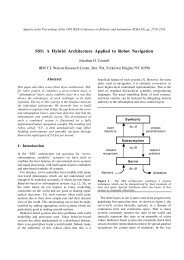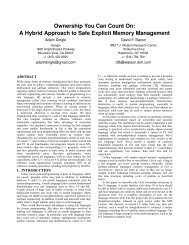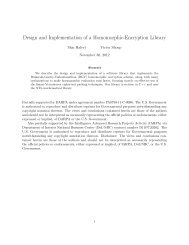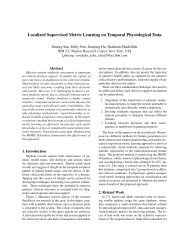On Nearly Orthogonal Lattice Bases and ... - Researcher - IBM
On Nearly Orthogonal Lattice Bases and ... - Researcher - IBM
On Nearly Orthogonal Lattice Bases and ... - Researcher - IBM
Create successful ePaper yourself
Turn your PDF publications into a flip-book with our unique Google optimized e-Paper software.
new properties of r<strong>and</strong>om bases <strong>and</strong> lattices; the paper [6] provides an excellent summary of the results wemention below.Consider an n × m matrix B with each element of B an independent identically distributed r<strong>and</strong>omvariable. If the variables are zero-mean Gaussian distributed with variance 1 n, then we refer to such a B as aGaussian r<strong>and</strong>om basis. If the variables take on values in {− √ 1 1n, √n } with equal probability, then we termB to be a Bernoulli r<strong>and</strong>om basis. We denote the eigenvalues of B T B by ψi 2 , i = 1,2,... ,m. Gaussian <strong>and</strong>Bernoulli r<strong>and</strong>om bases enjoy the following properties.1. For both Gaussian <strong>and</strong> Bernoulli B, B T B’s smallest <strong>and</strong> largest eigenvalues, ψmin 2 <strong>and</strong> ψ2 max, convergealmost surely to (1 − √ c) 2 <strong>and</strong> (1 + √ c) 2 respectively as n,m → ∞ <strong>and</strong> m n→ c < 1 [6, 12, 30].2. Let ɛ > 0 be given. Then, there exists an N ɛ such that for every n > N ɛ <strong>and</strong> r > 0,( ( √ ) ) mP |ψ min | ≤ 1 − − (r + ɛ) ≤ e − nr2ρ (18)n( ( √ ) ) mP |ψ max | ≥ 1 + + (r + ɛ) ≤ e − nr2ρ , (19)nwith ρ = 2 for Gaussian B <strong>and</strong> ρ = 16 for Bernoulli B [6, 18].In essence, a r<strong>and</strong>om matrix’s largest <strong>and</strong> smallest singular values converge, respectively, to 1 ± √ mn almostsurely as n,m → ∞ <strong>and</strong> lie close to 1 ± √ mnwith very high probability at finite (but sufficiently large) n.5.3 New Results on R<strong>and</strong>om <strong>Lattice</strong>sWe now formally state the new properties of r<strong>and</strong>om lattices mentioned in the Introduction plus severaladditional corollaries. The key step in proving these properties is to relate the condition number of a r<strong>and</strong>ombasis to its θ-orthogonality (see Lemma 2). A matrix’s condition number is defined as the ratio of the largestto the smallest singular value. Then we invoke the results in Section 5.2 to quantify the θ-orthogonality ofr<strong>and</strong>om bases. Finally we invoke previously deduced properties of nearly orthogonal lattice bases.We wish to emphasize that we prove our statements only for lattices which are not full-dimensional.Our computational results suggest these statements are not true for full-dimensional lattices. Further, Sorkin[31] proves that with high-probability, Gaussian r<strong>and</strong>om matrices are not nearly orthogonal when m > n/4.See the paragraph after Corollary 3 for more details.Lemma 2 Consider an arbitrary n × m real-valued matrix B, with m ≤ n, whose largest <strong>and</strong> smallestsingular values are denoted by ψ max <strong>and</strong> ψ min , respectively. Then the columns of B are θ-orthogonal with( )θ = sin −1 2ψmax ψ minψmin 2 + . (20)ψ2 maxThe proof is given in Section 5.4. The value of θ in (20) is the best possible in the sense that there is a 2 × 2matrix B with singular values ψ min <strong>and</strong> ψ max such that the angle between the two columns of B is given by(20). Note that for large ψ minψ max(that is, small condition number), the θ in (20) is close to π 2. Thus, Lemma 2quantifies our intuition that a matrix with small condition number should be nearly orthogonal.By combining Lemma 2 with the properties of r<strong>and</strong>om matrices listed in Section 5.2, we can immediatelydeduce the θ-orthogonality of an n × m r<strong>and</strong>om basis. See Section 5.4.2 for the proof.11


